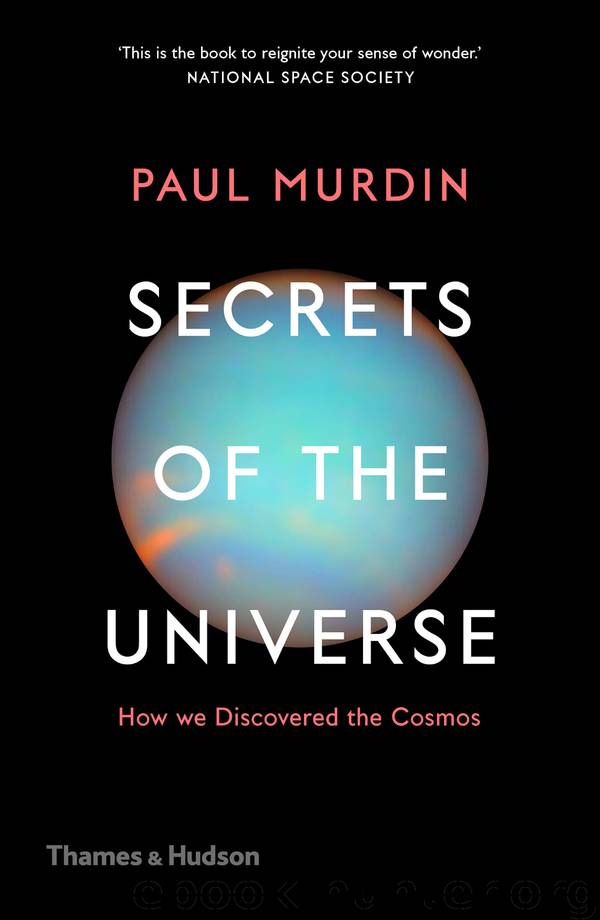Secrets of the Universe by Paul Murdin

Author:Paul Murdin
Language: eng
Format: epub
Publisher: Thames & Hudson Ltd.
Published: 2019-07-01T16:00:00+00:00
Distances of the Stars
The radiance of that star was shining years ago
Were a star quenched on high,
For ages would its light,
Still travelling downward from the sky,
Shine on our mortal sight.
Henry Wadsworth Longfellow, ‘Ode to Charles Sumner’, 1875
When we look at distant stars in the night sky, we are actually looking into the past. Since antiquity, astronomers knew that if a star was observed regularly from the same position, it ought to appear to move very slightly each year. They sought to discover these small movements to measure the distances of the stars from Earth. Most stars are so far away that their light takes years to reach the Earth.
Efforts to calculate the distances of the stars from Earth date back more than 2,000 years. The Greek astronomer Aristarchus of Samos in the fourth century BCE and Copernicus in 1543 CE both realized that if the Earth moves around the Sun, the fixed stars should move in a reflection of the Earth’s motion. This is manifestly not the case – the stars move very slightly, but nowhere near as much as the Sun’s rising and setting. Both men came to the same conclusion: the stars are much further away than the Sun, and consequently the radius of the Earth’s orbit is negligible compared with the distance of the stars.
The apparent movement of a star due to the Earth’s motion around the Sun is called the star’s annual parallax. ‘Parallax’ means the apparent shift of something due to the motion of the observer. Hold your finger up at arm’s length, and keep it still, but move your head from side to side. The finger moves against the background. The angle by which it moves is its parallax.
In 1580 the Danish astronomer Tycho Brahe built a vast pre-telescopic sighting instrument, called the Great Mural Quadrant, at his Uraniborg observatory on the island of Hven to measure star positions. It was mounted on a wall built precisely north–south to measure the altitude of stars as they passed due south. It had a brass measuring scale with a 2-metre radius, and was at the time the most accurate instrument ever built to measure star positions, but even Brahe could not determine the parallaxes of stars, as they were so far away. He concluded that the stars were more than 700 times more distant than the Sun.
Dutch scientist Christiaan Huygens took a different approach. If the Sun is a star and all stars are the same brightness, then the reason why the stars are so much fainter than the Sun is that they are further away and their light is diminished by distance – in fact by the amount of their distance squared. Huygens thought that if you could measure the relative brightness of the Sun and a star such as Sirius, then by finding the square root of the difference you could calculate the relative distances of the Sun and the star. Huygens tried to measure the brightness of Sirius relative to the Sun by covering the Sun’s face with a card pricked with different-sized holes.
Download
This site does not store any files on its server. We only index and link to content provided by other sites. Please contact the content providers to delete copyright contents if any and email us, we'll remove relevant links or contents immediately.
| Aeronautics & Astronautics | Astronomy |
| Astrophysics & Space Science | Comets, Meteors & Asteroids |
| Cosmology | Mars |
| Solar System | Star-Gazing |
| Telescopes | UFOs |
Tools of Titans by Timothy Ferriss(8216)
Turbulence by E. J. Noyes(7935)
Secrets of Antigravity Propulsion: Tesla, UFOs, and Classified Aerospace Technology by Ph.D. Paul A. Laviolette(5309)
Astrophysics for People in a Hurry by Neil DeGrasse Tyson(5130)
Room 212 by Kate Stewart(5035)
Design of Trajectory Optimization Approach for Space Maneuver Vehicle Skip Entry Problems by Runqi Chai & Al Savvaris & Antonios Tsourdos & Senchun Chai(5011)
Pale Blue Dot by Carl Sagan(4909)
The David Icke Guide to the Global Conspiracy (and how to end it) by David Icke(4624)
A Journey Through Divination and Astronomy by Publishing Pottermore(4344)
Goodbye Paradise(3726)
Apollo 8 by Jeffrey Kluger(3636)
COSMOS by Carl Sagan(3554)
Losing the Nobel Prize by Brian Keating(3498)
The Five People You Meet in Heaven by Mitch Albom(3474)
How to Read Water: Clues and Patterns from Puddles to the Sea (Natural Navigation) by Tristan Gooley(3406)
Brief Answers to the Big Questions by Stephen Hawking(3369)
How to Read Nature by Tristan Gooley(3249)
The Order of Time by Carlo Rovelli(3145)
A Brief History of Time by Stephen Hawking(2960)
